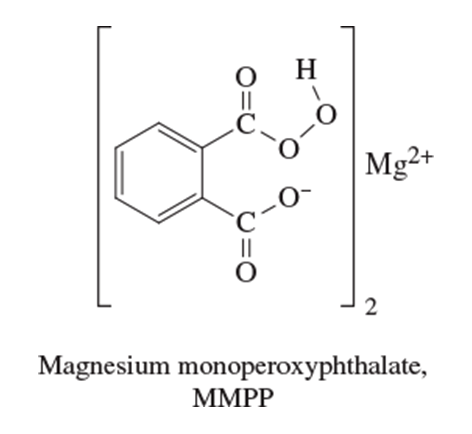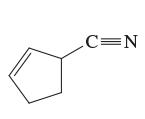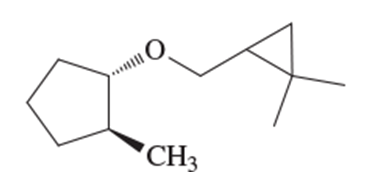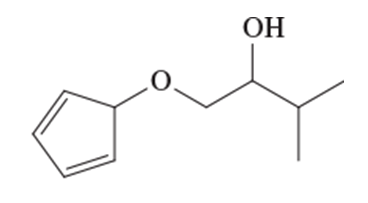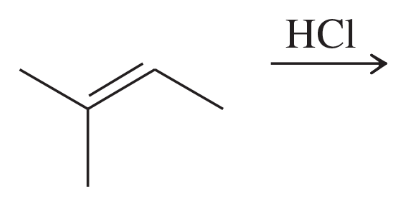 Back
BackProblem 31
Magnesium monoperoxyphthalate (MMPP) epoxidizes alkenes much like mCPBA. MMPP is more stable, however, and it may be safer to use for large-scale and industrial reactions. Propose a mechanism for the reaction of trans-2-methylhept-3-ene with MMPP, and predict the structure of the product(s).
Problem 32a
Predict the major products of the following reactions.
a. cis-hex-2-ene + mCPBA in chloroform
Problem 32b,c
Predict the major products of the following reactions.
b. trans-hex-3-ene + peroxyacetic acid (CH3CO3H) in water
c. 1-methylcyclohexene + MMPP in ethanol
Problem 32d,e
Predict the major products of the following reactions.
d. trans-cyclodecene + peroxyacetic acid in acidic water
e. cis-cyclodecene + mCPBA in CH2Cl2, then dilute aqueous acid
Problem 33
When 1,2-epoxycyclohexane (cyclohexene oxide) is treated with anhydrous HCl in methanol, the principal product is trans-2-methoxycyclohexanol. Propose a mechanism to account for the formation of this product.
Problem 34a,b
Predict the major products of the following reactions, including stereochemistry.
a. cyclohexene + KMnO4/H2O (cold, dilute)
b. cyclohexene + peroxyacetic acid in water
Problem 34c,d
Predict the major products of the following reactions, including stereochemistry.
c. cis-pent-2-ene + OsO4/H2O2
d. cis-pent-2-ene + peroxyacetic acid in water
Problem 34e
Predict the major products of the following reactions, including stereochemistry.
e. trans-pent-2-ene + OsO4/H2O2
Problem 34f
Predict the major products of the following reactions, including stereochemistry.
f. trans-pent-2-ene + peroxyacetic acid in water
Problem 35a
Show how you would accomplish the following conversions.
a. cis-hex-3-ene to meso-hexane-3,4-diol
Problem 35b
Show how you would accomplish the following conversions.
b. cis-hex-3-ene to (d,l)-hexane-3,4-diol
Problem 35c
Show how you would accomplish the following conversions.
c. trans-hex-3-ene to meso-hexane-3,4-diol
Problem 35d
Show how you would accomplish the following conversions.
d. trans-hex-3-ene to (d,l)-hexane-3,4-diol
Problem 36a
Give structures of the alkenes that would give the following products upon ozonolysis–reduction.
(a)
Problem 36b
Give structures of the alkenes that would give the following products upon ozonolysis–reduction.
(b)
Problem 36c
Give structures of the alkenes that would give the following products upon ozonolysis–reduction.
(c)
Problem 37a
Predict the major products of the following reactions.
(a) (E)-3-methyloct-3-ene + ozone, then (CH3)2S
Problem 37b
Predict the major products of the following reactions.
(b) (Z)-3-methyloct-3-ene + warm, concentrated KMnO4
Problem 37c,d
Predict the major products of the following reactions.
(c)
(d) 1-ethylcycloheptene + ozone, then (CH3)2S
Problem 37e
Predict the major products of the following reactions.
(e) 1-ethylcycloheptene + warm, concentrated KMnO4
Problem 37f
Predict the major products of the following reactions.
f. 1-ethylcycloheptene + cold, dilute KMnO4
Problem 38
a. Propose a mechanism for the following reaction.
2 (CH3)2C=CH–CH3 + cat. H+ → 2,3,4,4-tetramethylhex-2-ene
b. Show the first three steps (as far as the tetramer) in the BF3–catalyzed polymerization of propylene to form polypropylene.
Problem 43
Propose a mechanism for the triolefin process using a metal alkylidene as the catalyst.
Problem 44
Show what reagents would be needed to synthesize the pheromone of the omnivorous leafroller (OLR) using olefin metathesis to assemble the molecule at the double bond.
Problem 45a
Show how you would synthesize each compound, starting with alkenes or cycloalkenes that contain no more than six carbon atoms. You may use any additional reagents you need.
(a)
Problem 45b
Show how you would synthesize each compound, starting with alkenes or cycloalkenes that contain no more than six carbon atoms. You may use any additional reagents you need.
(b)
Problem 45c
Show how you would synthesize each compound, starting with alkenes or cycloalkenes that contain no more than six carbon atoms. You may use any additional reagents you need.
(c)
Problem 46a
Predict the major products of the following reactions, and give the structures of any intermediates. Include stereochemistry where appropriate.
(a)
Problem 46b
Predict the major products of the following reactions, and give the structures of any intermediates. Include stereochemistry where appropriate.
(b)
Problem 46c
Predict the major products of the following reactions, and give the structures of any intermediates. Include stereochemistry where appropriate.
(c)

